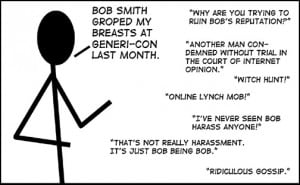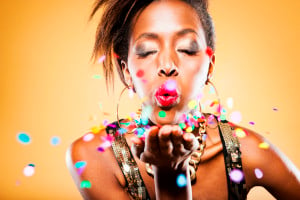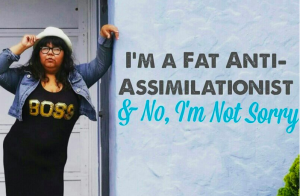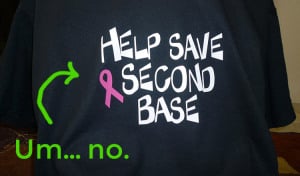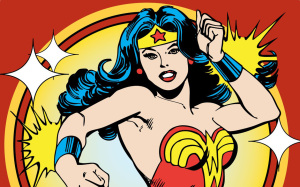
Source: Blastr
As a women’s, gender, and sexuality studies (WGS) major, I am accustomed to chatting about everything from checking your privilege to the gender binary to vaginas.
It’s not uncommon for a bunch of my fellow WGS friends to spend Friday nights chatting about the “Virgin Mary” or watching Jessica Valenti videos in an effort to procrastinate that paper on crisis pregnancy centers.
So when I decided to take a communications class about superheroes for a fun break in my senior schedule, you can bet that conversations about gender came up.
Superhero films are known for their male-centric nature.
In fact, the biggest superhero names have all been “attractive,” white, heterosexual men – the top of the privilege ladder. This comes as no surprise since these characters rule the box office across the board.
As a general studio rule, women will see movies about men, but men won’t see movies about women, so why make them?
That said, women are left sorting through the female characters that we are offered, and boy, is it grim.
The common question that comes up when chatting with people about the role of gender in superhero films is: “Well, he is sexy too, isn’t he? It’s unfair to both sexes.”
And the answer is yes, it is. But there’s more.
‘Women’s Stories’ Are Really Men’s Stories in Superhero Films
For the most part, men and women are both made to be “sexy” characters in film. Sex sells. We know this.
But for the female characters, the male gaze is utilized to hypersexualize the female character, further misrepresenting women in the media through visual depiction and the starvation of their personal agency.
Every major superhero film has been directed and written by a man.
This is not inherently bad, but it becomes problematic when only men tell stories about women.
The problem starts when you realize that none of these women actually have stories of their own. They all revolve around men.
So essentially, women’s stories are really men’s stories, too.
Take Laurie/Silk Spectre II in The Watchmen. She has little-to-no agency in major life moments.
For example, the first time that the audience is introduced to her relationship with her mother, another (male) character teleports her into the situation. She doesn’t choose to be there.
Similarly, Laurie’s character is understood not through her own doing, but through her relationships with others, almost entirely men (other than her mother).
She is understood as the seductress to Dan, the girlfriend to Jon, the deprived daughter to Silk Spectre, I but never as just herself, Laurie.
This lack of agency is not just relevant to The Watchmen though. It is present in all major superhero films.
Mary Jane (Spiderman) has to be saved, Rachel Dawes (Batman) is eventually a damsel in distress, and even the hailed “feminist” character Lois Lane becomes a love-struck puddle when it comes to Superman, constantly needing him to save the day.
The Male Gaze
Some of these female characters have very admirable qualities, don’t get me wrong.
I respect Lois Lane’s fierce reporting, Jane Foster’s scientific brilliance is enviable, and I’m continually impressed with Rachel Dawes’ fearless behavior in the face of injustice.
But every time I reach the end of each movie, I feel let down.
These female characters are usually boiled down to swooning props in the arms of a stable, impressive superhero.
This is a direct effect of the male gaze, a term Laura Mulvey, a British feminist film theorist, coined.
Mulvey states that, “In film, women are typically the objects, rather than the possessors, of gaze because the control of the camera (and thus the gaze) comes from factors such as the assumption of heterosexual men as the default target audience for most film genres. Women are the bearer of meaning, not the maker of meaning.”
Sexuality as a ‘Powerful’ Tool
So here is where it gets really problematic.
Because screenwriters have such a hard time writing female characters, it seems that the only way they know to give female characters in superhero films power is to hypersexualize them.
Because nothing is more powerful in a hegemonic culture than sex appeal, right?
The idea that women gain power from exerting their sexuality is frustrating, and here’s why: In a hegemonic culture, societal value is defined exclusively by heterosexual men (primarily, white men).
That means that if you’re really smart, that’s great, but if you’re super sexy, that’s when you really start obtaining some worth.
That doesn’t mean that you aren’t valued for anything else; it just means that you’re “attractiveness” is worth the most.
Consumer culture is obsessed with this to the point where women’s worth becomes a product to buy.
Ridiculous, right?
Visual Representation
Visual representation of female characters is key to understanding how the male gaze is used in these films.
The female superheroes (Catwoman, Electra, Silk Spectre I and II, Black Widow) aren’t wearing outfits that are comfortable to kick butt in. They are wearing them for the male viewer.
Have you ever tried doing a split in the air in tight leather pants while fighting off an evil villain? Not so practical.
And for many of these female characters, sex is their weapon.
A patriarchal society upholds the importance of dominance in sex, and the few ways women are afforded equal status to men is through a strong sexuality – which is defined as one that turns heterosexual men on, because it is for them.
And it is usually the costume that yields women any sort of power with men.
Sexual Exploitation ≠ Empowerment
“But these women are so empowered,” people cry! “Don’t they just own their sexuality?”
Sure. I could buy that if any of these female characters’ storylines didn’t revolve around primarily the men in their life. But they don’t. So, yeah, not buying that.
These female characters aren’t exerting sexuality because they want to. They’re doing it because they have to. It’s the only way they are afforded (somewhat) equal status to men.
Aside from just the way women are dressed, the male gaze is captured in camera angles as well.
The sex scene in The Watchmen features Laurie finally gaining some pleasure, which at first, seems to be for her.
The viewer quickly realizes that Laurie’s orgasm gives a pornographic subtext by doing quick shots of Laurie’s body as she experiences total ecstasy.
It seems that her pleasure is newfound for the sake of spectacle because the focus during the sex scene seems to be almost entirely on her sexualization and Dan’s complete surrender to the unbelievable nature of the act.
In other words, Laurie’s pleasure is not for herself, but for Dan’s gaze and for the male audience to place Dan onto an even higher pedestal.
Her pleasure is not for her. It’s for him.
For so many female characters, their infatuation with the male superhero does not seem to uplift their character up in any way; it only uplifts the male superhero.
Choices Are Not Their Own
Any power female characters are afforded is through their gender, which ends up objectifying them anyway.
While male characters are simply watched, female characters are watched as if men are looking at them.
This, in return, makes female characters objects, and any “choice” that they make in the film is not their own, but rather, done for someone else – for the male viewer.
Facing the Grim Reality
The complexities of the male gaze and its function in film must be explored when one refers to the fact that men and women are equally sexualized in superhero films.
The patriarchal structure of society sets up a power paradigm which values “normalized attractiveness” for all people, yes, but allows men to exist as individuals aside from their looks, whereas women are defined by theirs.
The more we hypersexualize women and attribute this to female, sexual empowerment, the more we reduce women everywhere.
Female characters in superhero films may appear to be empowered, but in reality, they are just props, objectified in order to exist in relation to the men, disserving women and men everywhere by strengthening gender roles and boosting gender inequality.
Now, Gwen Stacey, that’s a female character I can get behind.
Let’s all cross our fingers she is included in the next Spiderman movie and isn’t left to her (spoiler…) comic book fate!
In the meantime, we must all push for three-dimensional female characters whose personal agency is not swept under the rug, but celebrated as we tell their stories without the intrusion of the male gaze.
[do_widget id=”text-101″]
Amy Shackleford is a recent graduate from Wake Forest University, receiving a degree in Communication and Women’s and Gender Studies & Sexuality. She co-founded Gender Equality Allies, a student organization that aims to educate and raise awareness to gender issues such as body image, sexual misconduct, and stereotypes. Recently, Amy traveled to Paris to research the concept of beauty. Post-grad, she hopes to work for a feminist organization to fight injustice and spread the message of self-love. She also enjoys chocolate, traveling, and Shania Twain, always. Find her on Twitter @AnthemofAmy and Tumblr.
Search our 3000+ articles!
Read our articles about:
Our online racial justice training
Used by hundreds of universities, non-profits, and businesses.
Click to learn more






